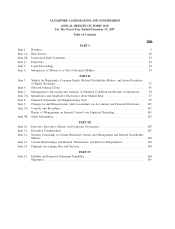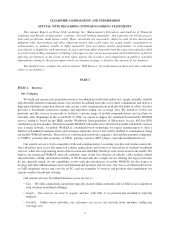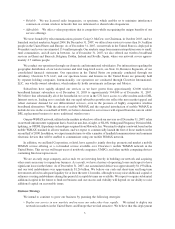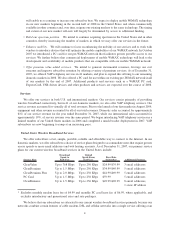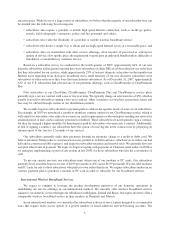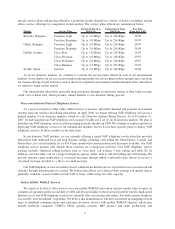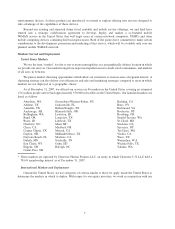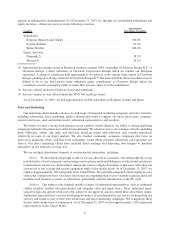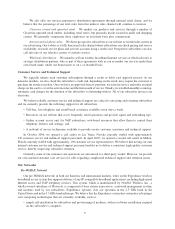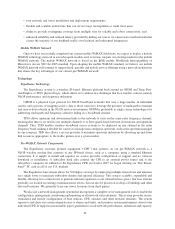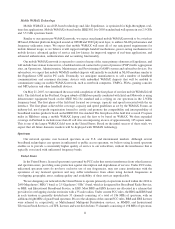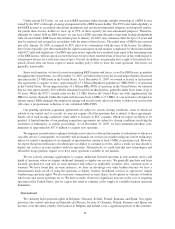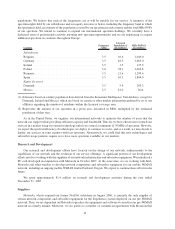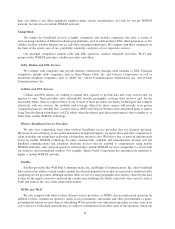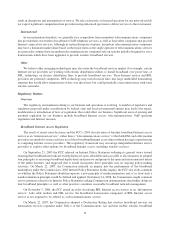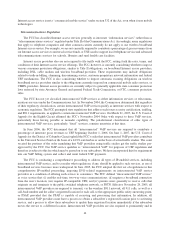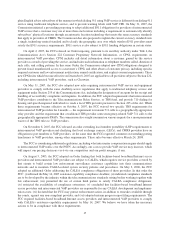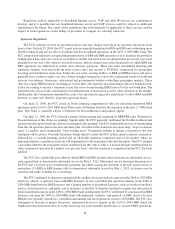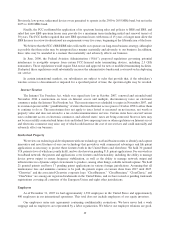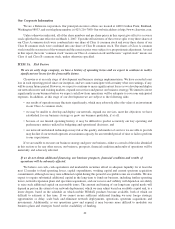Clearwire 2007 Annual Report Download - page 19
Download and view the complete annual report
Please find page 19 of the 2007 Clearwire annual report below. You can navigate through the pages in the report by either clicking on the pages listed below, or by using the keyword search tool below to find specific information within the annual report.Mobile WiMAX Technology
Mobile WiMAX is an all IP-based technology and, like Expedience, is optimized for high-throughput, real-
time data applications. Mobile WiMAX is based on the IEEE 802.16e-2005 standard and will operate in our 2.5 GHz
and 3.5 GHz spectrum bands.
Similar to our current pre-WiMAX network, we expect our planned mobile WiMAX network to be a wireless
IP-based, Ethernet platform designed around an OFDM and TDD physical layer, to address NLOS performance and
frequency utilization issues. We expect that mobile WiMAX will meet all of our anticipated requirements for
mobile Internet usage, as we believe it will support multiple handoff mechanisms, power-saving mechanisms for
mobile devices, advanced quality of service and low latency for improved support of real-time applications, and
advanced authorization, authentication and accounting functionality.
Our mobile WiMAX network is expected to consist of many of the same primary elements as Expedience, and
will include base station transceivers, a backhaul network connected to point of presence (POP) traffic aggregation
sites, an Operations, Administration, Maintenance and Provisioning (OAMP) system and subscriber devices. For
subscribers, we expect that mobile WiMAX enabled chipsets will initially be included in NLOS modems similar to
the Expedience CPE and in PC cards. Eventually, we anticipate manufacturers to sell a number of handheld
communications and consumer electronic devices with embedded WiMAX chipsets that will be enabled to
communicate using our mobile WiMAX network, such as notebook computers, UMPCs, PDAs, gaming consoles
and MP3 players and other handheld devices.
On May 21, 2007, we announced the successful completion of the first phase of our first mobile WiMAX field
trials. The field trial in the Portland, Oregon suburb of Hillsboro jointly conducted with Intel and Motorola is using
infrastructure equipment based on the IEEE 802.16e standard and is relying on our spectrum in the 2.5GHz
frequency band. The first phase of the field trial focused on coverage, capacity and speed associated with the air
interface. The first phase achieved the coverage, capacity and speed guidelines as set by the WiMAX Forum, an
industry-led, not-for-profit organization formed to certify and promote the compatibility and interoperability of
broadband wireless products based on the IEEE 802.16e standard. The first phase of the field trial covered 15 square
miles in Hillsboro using a mobile WiMAX laptop card, the first to be based on WiMAX. We then expanded
coverage in Portland to include more than 40 cell sites encompassing an area of approximately 145 square miles.
This is one of the largest WiMAX field tests in the United States. Based on the initial success of these trials, we
expect that all future domestic markets will be deployed with WiMAX technology.
Spectrum
Our network operates over licensed spectrum in our U.S. and international markets. Although several
broadband technologies can operate in unlicensed or public access spectrum, we believe using licensed spectrum
enables us to provide a consistently higher quality of service to our subscribers, without the interference that is
typically associated with unlicensed frequency bands.
United States
In the United States, licensed spectrum is governed by FCC rules that restrict interference from other licensees
and spectrum users, providing some protection against interruption and degradation of service. Under FCC rules,
unlicensed spectrum users do not have exclusive use of any frequencies, may not cause interference with the
operations of any licensed operators and may suffer interference from others using licensed frequencies in
overlapping geographic areas, making quality and availability of their services unpredictable.
We are designing our network in the United States to operate primarily on spectrum located within the 2496 to
2690 Megahertz (“MHz”) band, or 2.5 Gigahertz (“GHz”) band, which is designated for Broadband Radio Service,
or BRS, and Educational Broadband Service, or EBS. Most BRS and EBS licenses are allocated in a scheme that
provides for overlapping circular territories with a 35-mile radius. Under current FCC rules, the BRS and EBS band
in each territory is generally divided into 33 channels consisting of a total of 186 MHz of spectrum, with an
additional eight MHz of guard band spectrum. Prior to the adoption of the current FCC rules, BRS and EBS licenses
were referred to, respectively, as Multichannel Multipoint Distribution services, or MMDS, and Instructional
Television Fixed Services, or ITFS, licenses and were divided into 33 channels consisting of 198 MHz of spectrum.
11


